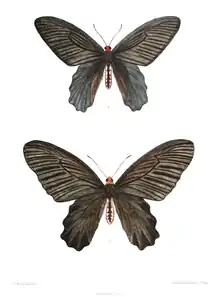Atrophaneura aidoneus
Atrophaneura aidoneus, the lesser batwing, is an Asian species of butterfly that belongs to the batwings group of Atrophaneura, comprising tailless black swallowtail butterflies.
| Lesser batwing | |
|---|---|
 | |
| Male (above) and female | |
| Scientific classification | |
| Kingdom: | |
| Phylum: | |
| Class: | |
| Order: | |
| Family: | |
| Genus: | Atrophaneura |
| Subgenus: | Atrophaneura |
| Species: | A. aidoneus |
| Binomial name | |
| Atrophaneura aidoneus Doubleday, 1845 | |
Description
- Wingspan: 112–162 mm.
- Male: Tailless. Above, the butterfly is bluish black and unmarked. It has a white scent patch in a square dorsal fold, which is pink or red on its marginal edge. This white scent patch is smaller than that of the common windmill.
- Female: Tailless. Above, the butterfly is grey brown. It has dark stripes between the veins.
Resembles Atrophaneura varuna race astorion, but differs as follows: Cell of forewing proportionately not quite so long; abdominal fold to the hindwing in male not so broad, its lower margin not square, rounded; the specialized scales within the fold white, with an edging of pink. Female larger. Upperside: ground colour olivaceous brown, never black; abdomen with a broad white, not crimson, lateral stripe.[1]
Range
Northern India, Bhutan, Burma, northern Vietnam, northern Laos, southern China (including Hainan (Guangdong province)).
In India, it is found in Uttarakhand, Sikkim, Assam, Meghalaya, Manipur and Nagaland.
Status
The butterfly is not common but not regarded as threatened.[2]
Taxonomy
No subspecies.
Habitat
The lesser batwing flies from April to November and frequents forests up to the altitude of 5,000 feet (1,500 m).
Habits
The lesser batwing is a shade-loving forest butterfly. It has a slow and graceful flight. Both sexes frequent flowers, often Lantana.
See also
Cited references
- Bingham, C.T. (1907). The Fauna of British India, Including Ceylon and Burma. II (1st ed.). London: Taylor and Francis, Ltd.
- Collins, N. Mark; Morris, Michael G. (1985). Threatened Swallowtail Butterflies of the World: The IUCN Red Data Book. Gland & Cambridge: IUCN. ISBN 978-2-88032-603-6 – via Biodiversity Heritage Library.
References
- Evans, W.H. (1932). The Identification of Indian Butterflies (2nd ed.). Mumbai, India: Bombay Natural History Society.
- Haribal, Meena (1992). The Butterflies of Sikkim Himalaya and Their Natural History. Gangtok, Sikkim, India: Sikkim Nature Conservation Foundation.
- Wynter-Blyth, Mark Alexander (1957). Butterflies of the Indian Region. Bombay, India: Bombay Natural History Society. ISBN 978-8170192329.